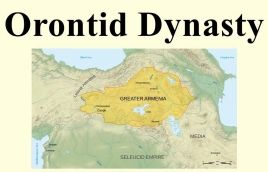Orontid dynasty
Thursday, February 3, 2022
The Orontid dynasty, also known by their native name Eruandid or Yervanduni, was a hereditary dynasty that ruled the Satrapy of Armenia until 330BC and the Kingdom of Armenia from 321BC to 200BC.
The Orontids ruled first as client kings or satraps of the Achaemenid Empire and after the collapse of the Achaemenid Empire established an independent kingdom. Later, a branch of the Orontids ruled as kings of Sophene and Commagene. They are the first of the three royal dynasties that successively ruled the ancient Kingdom of Armenia (321 BC–428 AD).
Historical background
Some historians state that the Orontids were of Iranian origin, and suggest that it held dynastic familial linkages to the ruling Achaemenid dynasty. Throughout their existence, the Orontids stressed their lineage from the Achaemenids in order to strengthen their political legitimacy.
Other historians state the Orontids were of Armenian origin, while according to Razmik Panossian, the Orontids probably had marriage links to the rulers of Persia and other leading noble houses in Armenia, and states their Armenian ethnicity is uncertain.
The name Orontes is the Hellenized form of a masculine name of Iranian origin; Երուանդ Eruand in Old Armenian. The name is only attested in Greek. Its Avestan connection is Auruuant (brave, hero) and Middle Persian Arwand. Various Greek transcriptions of the name in Classical sources are spelled as Orontes, Aruandes or Ardoates. The presence of this dynasty is attested from at least 400 BC, and it can be shown to have ruled originally from Armavir and subsequently Yervandashat. Armavir is called the "first capital of the Orontid dynasty".
The precise date of the foundation of the Orontid Dynasty is debated by scholars to this day but there is a consensus that it occurred after the destruction of Urartu by the Scythians and the Medes around 612 BC.
Language
Despite the Hellenistic invasion of Persia, Persian and local Armenian culture remained the strongest element within society and the elites.
The imperial administration used Aramaic, where it was used in official documents for centuries. Whereas most inscriptions used Old Persian cuneiform. Xenophon used an interpreter to speak to Armenians, while some Armenian villages were conversant in Persian.
The Greek inscriptions at Armavir indicate that the upper classes used Greek as one of their languages.Under Ervand the Last (r. ca. 210–200 B.C.), the structure of government had begun to resemble Greek institutions, and Greek was used as the language of the royal court. Ervand had surrounded himself by the Hellenized nobility and sponsored the establishment of a Greek school in Armavir, the capital of the Ervanduni kingdom.





